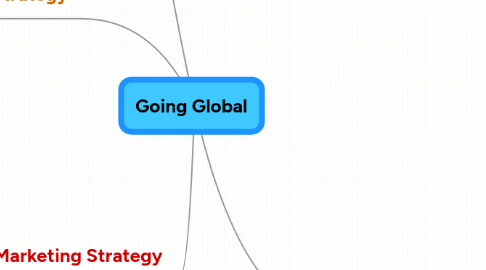
1. Global Marketing Strategy
1.1. Market-Entry Strategy
1.1.1. Exporting
1.1.1.1. merchants?
1.1.2. Contracutal Agreements
1.1.2.1. licensing
1.1.2.2. franchising
1.1.3. Strategic Alliances
1.1.4. Direct Investment
1.2. Born-Global Firms
1.2.1. global from beginning
2. Road Blocks at the Borders
2.1. Trade
2.1.1. Protected Trade
2.1.1.1. protectionism by government
2.1.1.2. import quotas
2.1.1.2.1. limited amount of products
2.1.1.2.2. expensive products
2.1.1.3. embargo
2.1.1.3.1. completely prohibiting import
2.1.1.4. tariffs
2.1.1.4.1. taxes on imports
2.1.2. countertrade
2.1.2.1. goods paid for with goods
2.1.3. GATT/WTO
2.1.3.1. treaty to reduce taxes + restrictions
2.1.4. Economic Communities
2.1.4.1. EU,APEC,NAFTA
3. Marketing Mix Strategy
3.1. localization strategy
3.1.1. specified marketing mix
3.2. standardization strategy
3.2.1. same mix everywhere
3.3. Product Decisions
3.3.1. straight extension
3.3.1.1. same product
3.3.2. product adaptation
3.3.2.1. kellogs loops
3.3.3. product invention
3.3.3.1. new product
3.4. Promotion Decisions
3.5. Price Decisions
3.6. Distribution Decisions
4. Global Marketing Environment
4.1. Economic Environment
4.1.1. GDP
4.1.1.1. value of all produced g&s
4.1.1.2. per capita: /inhabitants
4.1.2. GNP
4.1.2.1. GDP, national firms outside
4.1.3. economic infrastrucutre
4.1.3.1. quality of distribution, financial + communication system
4.1.4. level of ec. development
4.1.4.1. LDCs
4.1.4.2. Developing Countries
4.1.4.3. Developed Countries
4.1.5. Business cycle
4.1.5.1. prosperity
4.1.5.2. recession
4.1.5.3. recovery
4.2. The Competitive Environment
4.2.1. analyzing
4.2.1.1. competitive intelligence
4.2.1.1.1. analyzing publicly available info about rivals
4.2.2. microenvironment
4.2.2.1. product alternatives
4.2.2.2. discretionary income
4.2.2.2.1. income left
4.2.2.3. product competition
4.2.2.4. brand competition
4.2.3. macroenvironment
4.2.3.1. monopoly
4.2.3.2. oligopoly
4.2.3.3. monopolistic competition
4.2.3.4. perfect competition
4.2.4. Political + Legal Environment
4.2.4.1. political constraints on trade
4.2.4.1.1. war
4.2.4.2. regulatory constraints
4.2.4.3. human rights issues
4.2.5. Sociocultural Environment
4.2.5.1. basic beliefs
4.2.5.2. demographics
4.2.5.2.1. size/age/gender etc
4.2.5.3. cultural values
4.2.5.3.1. collectivist cultures
4.2.5.3.2. individualist cultures
4.2.5.4. norms
4.2.5.4.1. customs
4.2.5.4.2. mores
4.2.5.4.3. conventions
4.2.5.5. ethnocentrism
4.2.5.5.1. tendency to prefer own products
